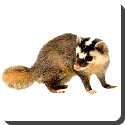 Badger — Badger is the common name for any animal of three subfamilies, which belong to the family Mustelidae: the same mammal family as the ferrets, the weasels, the otters, and several other types of carnivore. There are eight species of badger, in three subfamilies: Melinae (badgers of Europe and Asia), Mellivorinae (the Ratel or honey badger), and Taxideinae (the American badger). The Asiatic stink badgers of the genus Mydaus were formerly included in the Melinae, but recent genetic evidence indicates that these are actually Old World relatives of the skunks (family Mephitidae). Typical badgers (Meles, Arctonyx, Taxidea and Mellivora species) are short-legged and heavy-set. The lower jaw is articulated to the upper by means of a transverse condyle firmly locked into a long cavity of the cranium, so that dislocation of the jaw is all but impossible. This enables the badger to maintain its hold with the utmost tenacity, but limits the jaw movement to hinging open and shut or sliding from side to side; it does not allow yawning as in most other mammals (including humans).
Badger — Badger is the common name for any animal of three subfamilies, which belong to the family Mustelidae: the same mammal family as the ferrets, the weasels, the otters, and several other types of carnivore. There are eight species of badger, in three subfamilies: Melinae (badgers of Europe and Asia), Mellivorinae (the Ratel or honey badger), and Taxideinae (the American badger). The Asiatic stink badgers of the genus Mydaus were formerly included in the Melinae, but recent genetic evidence indicates that these are actually Old World relatives of the skunks (family Mephitidae). Typical badgers (Meles, Arctonyx, Taxidea and Mellivora species) are short-legged and heavy-set. The lower jaw is articulated to the upper by means of a transverse condyle firmly locked into a long cavity of the cranium, so that dislocation of the jaw is all but impossible. This enables the badger to maintain its hold with the utmost tenacity, but limits the jaw movement to hinging open and shut or sliding from side to side; it does not allow yawning as in most other mammals (including humans).
The behavior of badgers differs by family, but all shelter underground, living in burrows called setts. Some are solitary, moving from home to home, while others are known to form clans of up to 15. Badgers are fierce animals and will protect themselves and their young at all costs. Badgers are capable of fighting off much larger animals such as wolves, coyotes and bears.
North American Badgers (Taxidea taxus) are carnivorous and prey predominantly on pocket gophers (Geomyidae), ground squirrels (Spermophilus), moles (Talpidae), marmots (Marmota), prairie dogs (Cynomys), woodrats (Neotoma), kangaroo rats (Dipodomys), deer mice (Peromyscus), and voles (Microtus). They also prey on ground-nesting birds (such as bank swallow or sand martin Riparia riparia and burrowing owl Athene cunicularia), lizards, amphibians, carrion, fish, hibernating skunks (Mephitis and Spilogale), insects, including bees and honeycomb, and some plant foods, such as corn (maize, Zea mais), peas, green beans, mushrooms and other fungi, and sunflower seeds (Helianthus). Unlike many carnivores that stalk their prey in open country, badgers catch most of their food by digging. They can tunnel after ground dwelling rodents with amazing speed. They have been known to cache food.
 Kids Portal For Parents India Kids Network
Kids Portal For Parents India Kids Network






